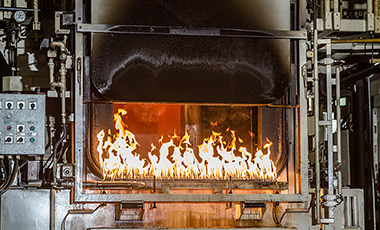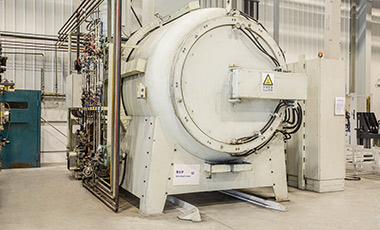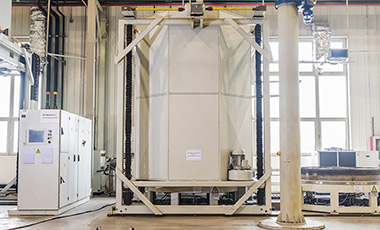Heat & surface treatment
Heat treatment
Heat & surface treatment
The term martensitic hardening refers to a heat treatment process consisting of austenitization and cooling under conditions that produce an increase in hardness through the more or less complete transformation of austenite into martensite.
Austenitization is the treatment step in which the workpiece is brought to the austenitizing temperature and full phase transformation and carbide dissolution change the matrix of the steel to austenitic.
Austenitization is followed by the cooling step. To ensure that the entire workpiece assumes a martensitic structure, the speed of the temperature drop must be greater than the critical cooling rate of the particular steel.
- Cooling can be carried out in a range of different media characterized by their cooling effects in the different temperature ranges.
- High strength
- Good strength and toughness after tempering

Case hardening is one of the thermochemical processes. In this process, the surface layer of components and tools is carburized with a carbon-emitting medium and then quenched, improving the mechanical properties (e.g. wear) of the component's surface layer.
Carburization is usually at temperatures of 880 to 950° C. After the hardening of the carburized parts, Tempering is generally required to reduce the stresses resulting from hardening and to achieve the required strength.
A range of different systems such as chamber furnaces and continuous furnaces are available for case hardening. Oils are generally the media used for quenching.
- High surface hardness
- Good wear resistance
- Good shock resistance
Vacuum hardening is a heat treatment process which heating the wordpieces in the vacuum condition compare to the protective atmosphere, which bring us following advantages:
- Dissociation of pre-existing oxides
- Bright, Oxide free treatment of most metals, especially free inter-granular oxidation(IGO)
- No risk of contamination, for example “hydrogen embrittlement”, “carbon pick up”, especially for the high strength steel which need good fatigue resistance
- Lower distorsion which following by high pressure gas quenching
- Environmentally, vacuum heat treatment is a clean process
- Production flexible, restarting from room temperature of every batch

The process of adding nitrogen to the surface of a steel usually from dissociated ammonia as the source. Nitriding develops a very hard case after a long time at comparatively low temperature, i.e. 480°C to 530°C without quenching. No further heat treatment is necessary.
- High wear resistance against abrasion and adhesion
- Little distortion
- Creation of corrosion resistant layers
- Reduction of coefficients of friction
- High temperature strength and tempering resistance of the surface layers to about 500° C

Plasma nitriding is one of the thermochemical heat treatment processes and is carried out at temperatures between 350 and 600° C.
Positively charged ions strike the workpieces connected as a cathode in front of the furnace wall (anode) with a high impact speed.
Initially, this ion bombardment results in a very intense cleaning of the workpiece surface (sputtering), followed by the heating and nitriding of the surface.
Advantages compare to gas nitriding:
- Smaller distortion
- Adaptation of layers to wear type
- Partial nitriding much easier to achieve
- Environmentally,less gas consumption
- No additional depassivation for stainless steel nitriding
- Titanium nitriding

Nitriding of stainless steel is much complicated compare to other material, due to the compact oxide layer on the surface. That means an activation process before nitriding to remove the oxidation layer is critical.
Advantages
- Enhance surface strength and wear resistance, especially adhesive wear resistance
- Keep the corrosion resistance
The term annealing refers to the treatment of a workpiece at a given temperature for a given time period, with the subsequent cooling adapted to achieve the required material properties.
- The major annealing processes are as follows
- Stress-relief annealing
- Soft annealing
- Spheroidized annealing
- Diffusion annealing
- Isothermal annealing
- Full annealing
- Recrystallization annealing
- Solution annealing

Industry applications
Automotive
Building services engineering
Consumer goods
Electrical engineering
Mechanical engineering and equipment manufacturing
Medical technology
Precision engineering
Textile industry
Other
